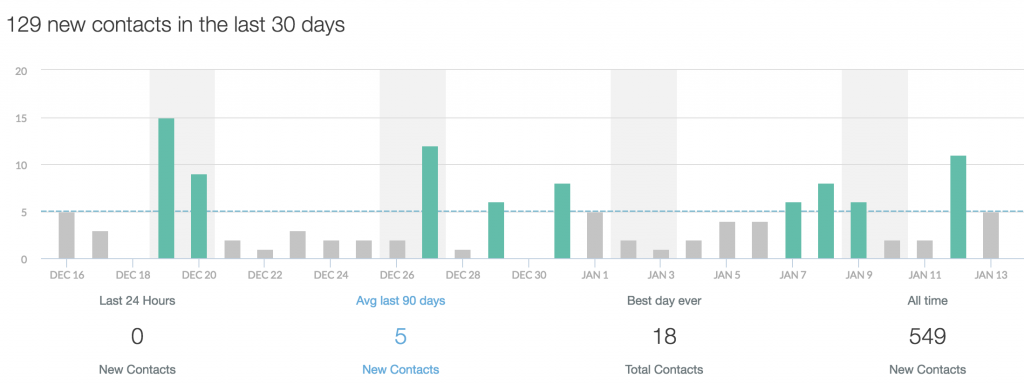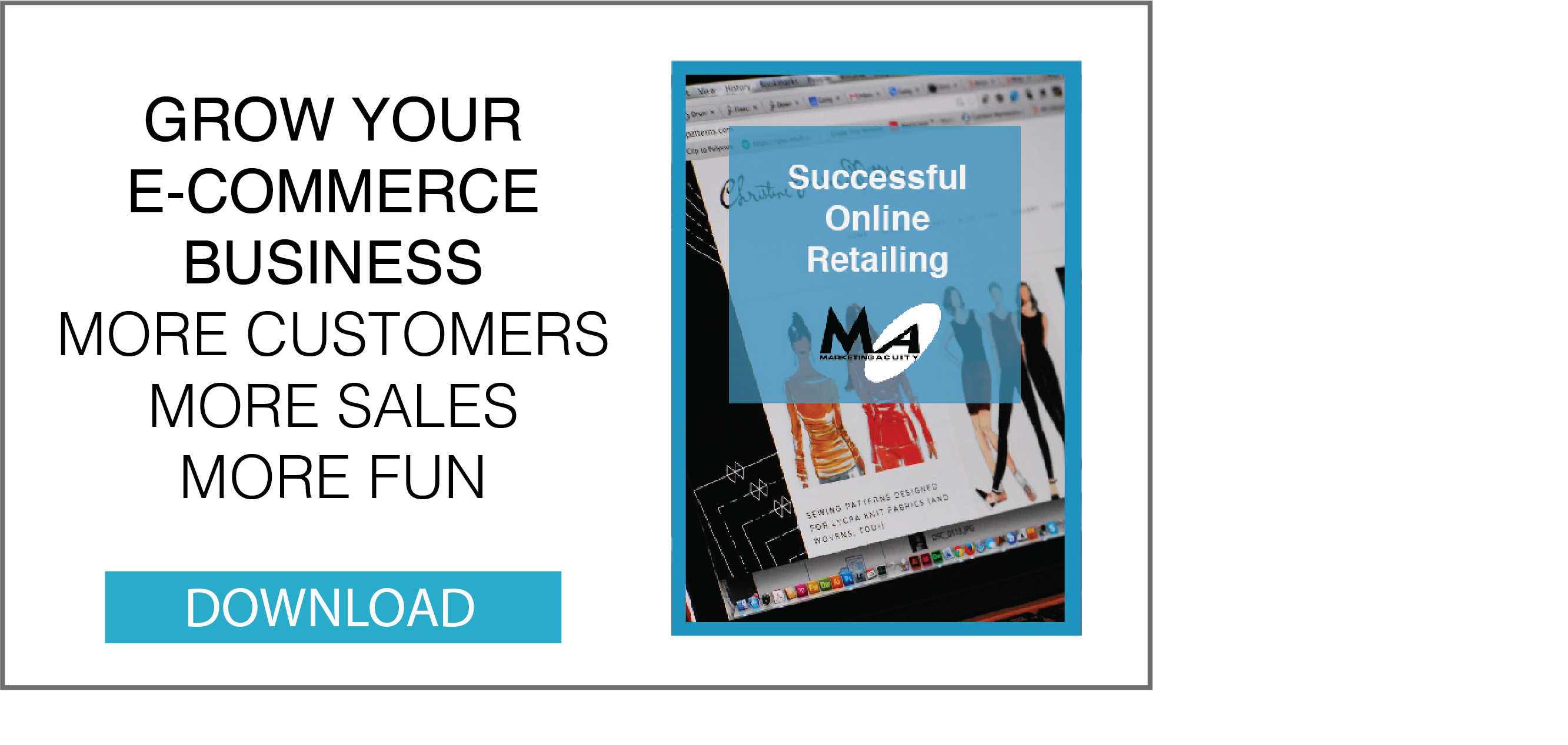How can content development, lead capture tools, Facebook and Twitter can generate 30 new leads a week for your retail e-commerce store? Lead generation tools, plus social media marketing and blogging are a powerful small business and retail e-commerce combination that works for e-commerce retailers.
Let’s look at the combination that is working so well for a client that they’re generating more than 30 qualified leads a week, on average, and have boosted sales 500% in one quarter. We’ll first define what we’re using, then we will explore the secret sauce that is juicing up this retail commerce client’s business.
Lead generation and lead capture tools:
There are many lead generation and lead capture tools out there. This client is using Hubspot’s Leadin capture and analytics system. Leadin connects to the client’s Constant Contact email service. The client has always had Constant Contact signups (and popups) on her site. But switching to the Leadin slide up popup on 50% of content scroll has invigorated signups to the tune of more than 30 new signups per week.

Lead nurturing tools:
The client uses Constant Contact to communicate via e-mail with the leads captured by Leadin. Leadin is a free tool, and Constant Contact is $70 per month for the client’s nearly 5,000 member e-mail database.
Social media marketing:
This client’s social channels are focused in on Facebook, Twitter and Pinterest. Their market skews older (women 35-70) and Facebook is a sweet spot for this audience. Many of their initial site visits come from the social network. The client has not done any advertising or sponsored posts on Facebook. After the Facebook algorithm change a year ago, the only post types we use on Facebook are content-based. If the client has a promotional message, that is sent first on e-mail or in a private Facebook group to members only. This content-only focus has enabled an engagement rate much higher than average for Facebook.
Content:
This client’s content centers around how-to, DIY, fashion and creativity. So visual content is critical. The visual content consists of photographs (either a photo shoot or picture content developed from fashion-centric tools such as Polyvore) or line-drawn graphics from the product packaging itself. Written content is almost always a how-to or an inspirational idea post on the client’s integrated blog and includes an example photo.
Content is produced for the blog weekly and on Facebook every few days. Shorter versions are cross posted with hashtags to Twitter and shared on Pinterest in appropriate categories.
The Content Marketing Process:
Content is created first. We use a loosely arranged content calendar (adapting content to current discussions on the Facebook private group is key to engagement) that contains a monthly topic area of focus. Photography, done in advance, usually quarterly, is dropped in to a blog article and then cross-posted to Facebook and Twitter. The posts contain either helpful how-to articles, or inspirational content featuring images and ideas for using the client’s products in new ways.
New visual content is created in the fashion editor Polyvore, a site where fashion outfits can be collaged in a visual interface and shared across social media. Images of the client’s own products mixed with current fashion trends help show the customer how they can achieve the same fashion looks with their DIY sewing creations.
Video content is a new area for this client, as she prefers to be ‘behind the scenes’. In this case, the marketing team is producing and starring in how-to video content so the client can remain behind the camera lens.
Content brings and keeps customers on the web site. Our team makes notes of customer searches for how-to topics in our Leadin form submissions, and we track keyword search terms in Google Analytics monthly. From there, we develop content that matches those keywords or align current planned content around those keyword long-tail search terms.
Use social media posts to drive traffic to the web site:
Many of the newest visitors to the client’s site landed there from a Facebook post or a Pinterest post. They are searching for relevant content on a fashion / DIY topic, find the client’s post, then visit the site. Social media is a major driver of traffic to this client’s site and engagement on Facebook is high.
Capture prospective customers with Leadin:
Once visitors land on the web site, we capture them with the free lead conversion tool Leadin from Hubspot. While Hubspot can be a challenging investment for a retail client selling low-cost products online, the free Leadin tool allows the client to utilize the best parts of Hubspot – the lead capture and analytics – in a streamlined, easy product. The leads then flow directly into Constant Contact, the client’s e-mail service (they have utilized this for about a decade or more.) Hubspot’s starter edition, at $200/month is a very affordable step up from free Leadin+email marketing tools.
The e-mails are sent to two groups of customers – the existing customer base and the Leadin base. They are sent twice per month and rarely contain promotional information, but focus heavily on the DIY/Style/How-to content. Included in every email is an invitation to the private Facebook Group. When e-mails are sent, requests to join the Facebook group jump up significantly for a couple of days.
Within a day, a welcome post is placed on the Facebook group, welcoming the new members and requesting their introductions. Other members of the group join in and welcome the new members, and a community grows. The community has become self sustaining, and has a volunteer member monitor who can help with questions and alert the marketing team if there are issues that the company needs to address (such as product, customer service or ordering.)
Host regular virtual events:
To further foster visits to the web site (and product purchases), about every other month, the client hosts a virtual DIY event where members make a particular project together at the same time. They sew in their own sewing rooms, but the event creates a concentrated discussion about fit, fabric and shared photos of success all around a common project (and love.) Everyone sews the same garment, so many purchase the pattern (or the fabric and pattern kit) from the web site. Invariably, they order more of other products as well, at the same time. This last step in the process of lead gen to sales has boosted sales 500% in just one quarter. The client typically does not receive a holiday season boost (because most of the members are sewing for others, not for themselves) so the increase in sales comes at a time when sales are typically lower than the rest of the year.
Once this cycle starts, it gets a momentum of it’s own, if regularly fed with new content and events. The incremental work of a few more emails per year and a few more social posts per week is a fair trade for greatly increased sales and engagement among customers.






